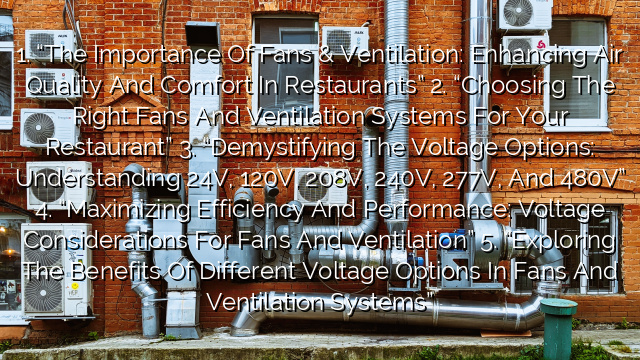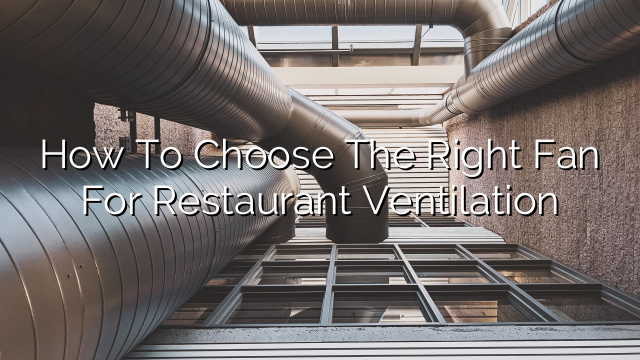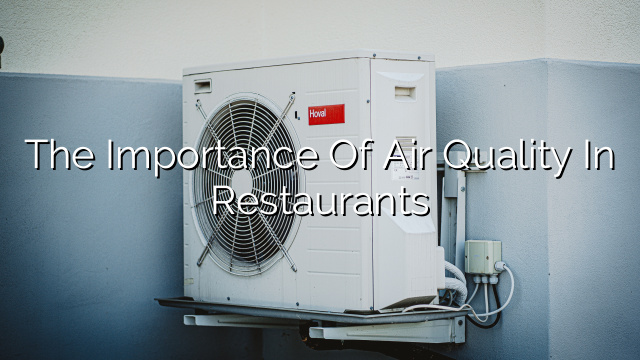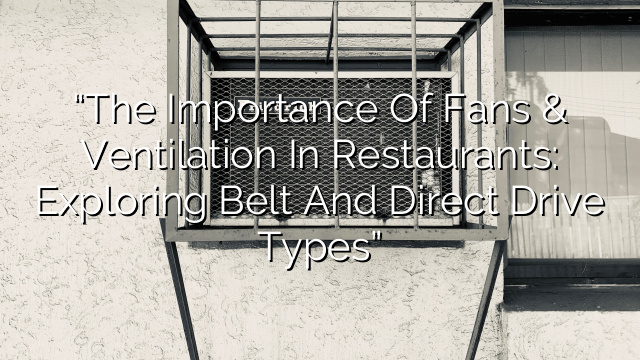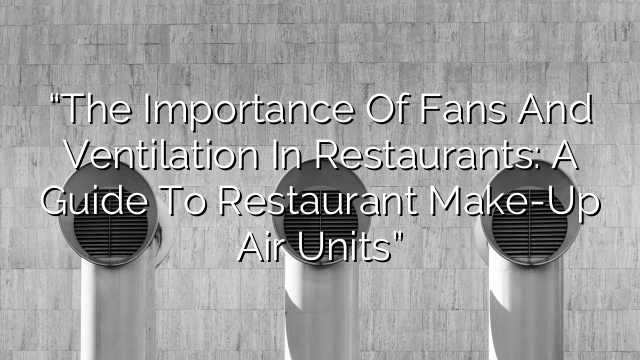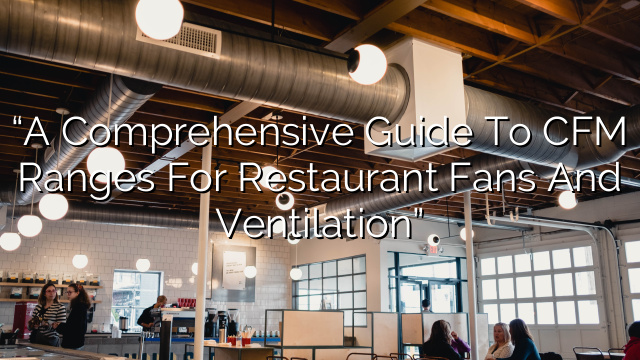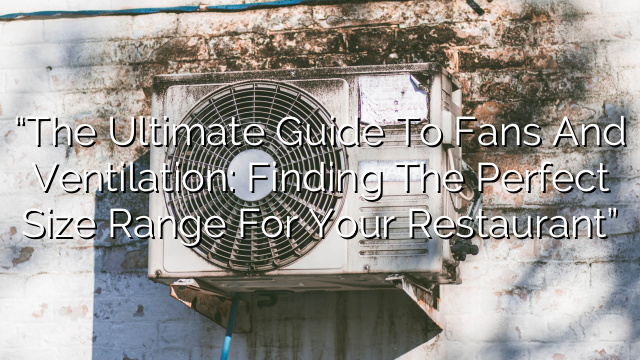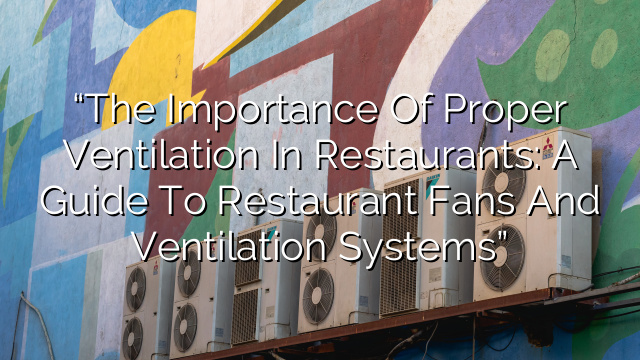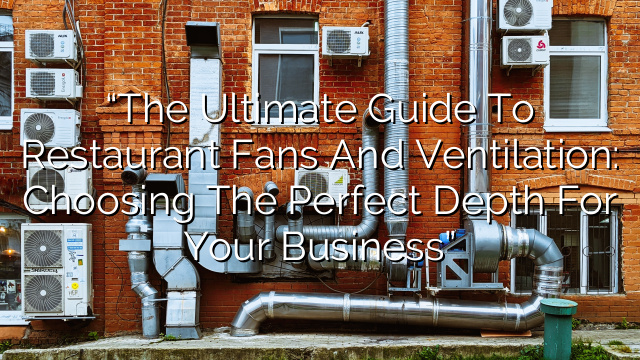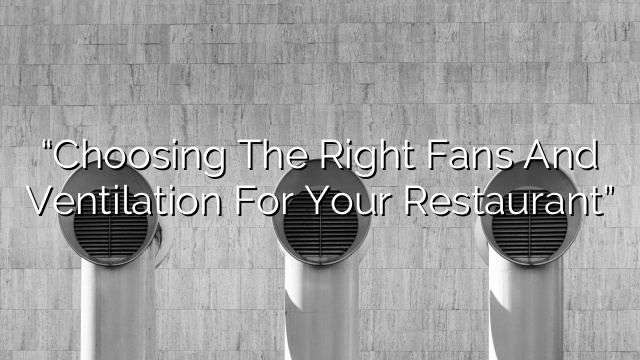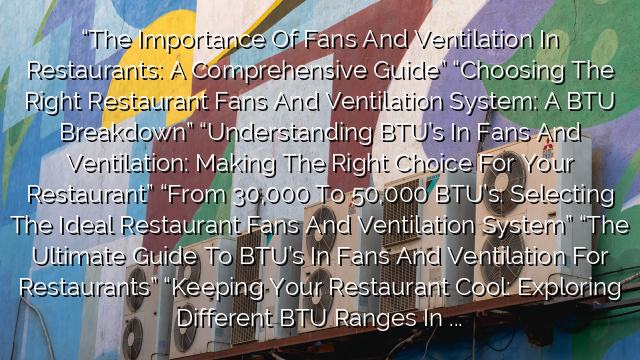The Importance of Fans & Ventilation: Enhancing Air Quality and Comfort in Restaurants
When it comes to running a successful restaurant, there are certain factors that are crucial to consider. One of the aspects that often gets overlooked is the importance of fans and ventilation systems. Proper air circulation and ventilation play a vital role in maintaining a comfortable environment for both the staff and customers, ensuring better air quality and minimizing odors. In this article, we will discuss the significance of fans and ventilation in restaurants, how to choose the right systems, and explore the various voltage options available.
Choosing the Right Fans and Ventilation Systems for Your Restaurant
1. Assess your restaurant’s needs: Before you start looking for fans and ventilation systems, it’s important to evaluate your restaurant’s specific requirements. Consider factors such as the size of the space, the number of cooking appliances, and the overall layout. This will help you determine the type and size of fans and ventilation systems that would best suit your establishment.
- Exhaust Fans: These fans are designed to remove smoke, grease, and odors from the kitchen area. They are typically installed above cooking appliances like stoves and grills. Exhaust fans are essential for maintaining a clean and comfortable environment while preventing the buildup of harmful pollutants.
- Supply Fans: Supply fans bring in fresh air from outside and distribute it throughout the restaurant. They work in conjunction with exhaust fans to ensure proper air circulation. Supply fans also help in maintaining a comfortable temperature for both staff and customers.
- Make-Up Air Systems: Make-up air systems replace the air being exhausted from the kitchen with fresh outdoor air. These systems ensure proper ventilation and help maintain the right balance of air pressure in the restaurant. This is especially important in commercial kitchens where a significant amount of air is being exhausted through the exhaust fans.
- Roof Ventilation Systems: Roof ventilation systems help remove hot air, humidity, and grease vapors from the kitchen. They are typically installed on the roof and work in tandem with other ventilation components to optimize air quality and reduce the risk of fire hazards.
2. Consider noise levels: Restaurant environments can be bustling and loud. When choosing fans and ventilation systems, it’s important to consider the noise levels they produce. Opt for fans that have noise reduction features or can be installed with sound attenuation panels to minimize disturbances for customers and staff.
3. Energy efficiency: Fans and ventilation systems can consume a significant amount of energy. Look for systems that are energy efficient and have high-performance ratings. Energy-efficient systems not only help reduce utility costs but also have a positive impact on the environment.
4. Maintenance and cleaning: Restaurant fans and ventilation systems can accumulate grease and debris over time. Considering the ease of maintenance and cleaning is crucial when selecting these systems. Look for fans and ventilation systems that are designed for easy access and cleaning, ensuring a hygienic and efficient operation.
Demystifying the Voltage Options: Understanding 24V, 120V, 208V, 240V, 277V, and 480V
When it comes to fans and ventilation systems, voltage plays a crucial role in determining their performance and compatibility with your restaurant’s electrical system. Understanding the different voltage options available will help you make an informed decision.
- 24 Volts: This low voltage option is commonly found in small appliances and residential HVAC systems. It is not typically used in commercial restaurant fans and ventilation systems.
- 120 Volts: The most common voltage option used in residential and commercial applications. It is suitable for smaller restaurants or areas where the power demand is relatively low.
- 208 Volts: This voltage option is commonly found in larger commercial establishments. It is ideal for medium-sized restaurants or places with higher power demands.
- 240 Volts: Another common voltage option used in commercial applications. It is ideal for larger restaurants with heavy power requirements.
- 277 Volts: Primarily used in commercial and industrial settings, this voltage option is suitable for larger restaurants with high power demands.
- 480 Volts: This high voltage option is typically used in industrial applications. It is rarely used in restaurant fans and ventilation systems unless the restaurant has specific power requirements.
Before making a decision, consult an electrician or HVAC professional who can guide you in choosing the right voltage option based on your restaurant’s electrical system and power requirements.
Maximizing Efficiency and Performance: Voltage Considerations for Fans and Ventilation
Choosing the appropriate voltage for your restaurant fans and ventilation systems is crucial for their overall efficiency and performance. Here are some key considerations:
- Electrical Compatibility: Ensure that the voltage of the fans and ventilation systems aligns with the electrical supply available in your restaurant. Failure to do so can lead to equipment damage and inefficient operation.
- Power Demands: Assess your restaurant’s power demands and select a voltage option accordingly. Larger establishments with heavy power loads may require higher voltages to meet their ventilation requirements.
- Energy Efficiency: Higher voltage options can offer better energy efficiency, which can lead to reduced utility costs in the long run. However, it is important to ensure that your electrical system is adequately equipped to handle the increased voltage.
- Equipment Selection: The voltage options available may impact the range of fans and ventilation systems you can choose from. Be sure to check the voltage specifications of the equipment you are interested in to ensure compatibility.
By considering these factors and consulting with professionals, you can select the right voltage option that maximizes the efficiency and performance of your restaurant fans and ventilation systems.
Exploring the Benefits of Different Voltage Options in Fans and Ventilation Systems
1. Enhanced Performance: Higher voltage options, such as 240V or 277V, can provide increased power and airflow capabilities. This leads to better performance and improved air circulation in larger restaurants or areas with higher ventilation demands.
2. Energy Efficiency: Higher voltage options are generally more energy efficient compared to lower voltage options. They require less current to deliver the same power output, resulting in reduced energy consumption and lower utility bills.
3. Increased Lifespan: Fans and ventilation systems operating at higher voltages tend to have longer lifespans. This is because they operate at lower temperatures and experience less strain on their components. Investing in higher voltage options can result in longer-lasting equipment, reducing maintenance and replacement costs.
4. Gains in HVAC System Performance: Some restaurant fans and ventilation systems are designed to work in conjunction with HVAC (Heating, Ventilation, and Air Conditioning) systems. Higher voltage options can improve the overall performance of the HVAC system, resulting in better temperature control, humidity management, and more efficient energy usage.
FAQs
Q: Are fans and ventilation systems necessary for all types of restaurants?
A: Yes, fans and ventilation systems are essential for all types of restaurants. They help maintain air quality, remove odors and smoke, and prevent the buildup of harmful pollutants.
Q: Can I install fans and ventilation systems myself?
A: It is highly recommended to consult with a professional electrician or HVAC technician for the installation of fans and ventilation systems. They have the expertise and knowledge to ensure safe and efficient installation.
Q: How often should I clean and maintain my fans and ventilation systems?
A: The frequency of cleaning and maintenance depends on the specific needs of your restaurant. However, it’s generally recommended to clean and inspect your fans and ventilation systems regularly to prevent the accumulation of grease and debris, and to ensure optimal performance.
Q: Are there any additional safety measures I should consider when installing fans and ventilation systems?
A: Yes, it is important to comply with local building codes and regulations when installing fans and ventilation systems. Ensure proper clearance from combustible materials, use appropriate venting materials, and install safety switches or controls when necessary.
Q: Can I save money by opting for a lower voltage option for my fans and ventilation systems?
A: While lower voltage options may initially cost less, it’s important to consider the power demands and performance requirements of your restaurant. Choosing a lower voltage option may lead to inefficient operation, increased wear and tear, and higher long-term maintenance costs.
In conclusion, fans and ventilation systems play a crucial role in maintaining a comfortable and safe environment in restaurants. By understanding the different options available and considering your restaurant’s specific needs, you can choose the right fans and ventilation systems that enhance air quality, improve performance, and contribute to a better overall dining experience.

